There are two paradigms of stock tokenization: the opening of xStocks and the walls of Robinhood
Words: Aiying Research
The tokenization of Real-World Assets (RWA) is no longer a futuristic narrative of self-congratulatory blockchain circles, but a financial reality that is happening. In particular, the tokenization of stocks has begun with the entry of fintech giants such as Kraken and Robinhood, a structural change driven by blockchain technology. For the first time, global investors have the opportunity to trade "digital stocks" of companies such as Apple and Tesla 24/7 in a near-frictionless manner. However, under the hustle and bustle of the market, deeper questions need to be answered. The book continues from the previous session "From Retail Paradise to Financial Disruptor: An In-depth Breakdown of Robinhood's Business Landscape and Future Chess Game", Aiying's report aims to penetrate the surface of market hotspots and deeply analyze the internal logic of current mainstream stock tokenization products. We will no longer stop at the "what" level, but focus on the "how" and "what's at risk", providing our clients, investors, developers and regulators with a reference map that is both in-depth and practical.
Aiying will conduct an in-depth comparative analysis of two typical cases - xStocks (issued by Backed Finance and traded by exchanges such as Kraken) that represents the "open DeFi" path and Robinhood which represents the "compliance walled garden" path, supplemented by the practices of key industry players such as Hashnote and Securitize, to jointly explore a core question:
How do these platforms balance stringent financial regulation, complex technology implementations, and huge market opportunities? What paths did they choose, and how did their underlying logic and compliance design fundamentally differ? This is the core of what this report will reveal.
1. Core analysis (1): The "mantra" and "talisman" of compliance - the underlying logic of the two mainstream models
The number one challenge with stock tokenization is not technology, but compliance. Any attempt to "onboard" traditional securities to the blockchain will have to confront the intricacies of global financial regulations. In the long-term battle with regulation, the market has quietly diverged into two very different compliance paths: 1:1 asset-backed security tokens and derivatives contract tokens. The underlying legal structure and operational logic of these two models are very different, which determines their product forms, user rights and risk characteristics. Let's break them down one by one.
Mode 1: xStocks – Embracing the open path to DeFi
Core Definition: A user's token holdings (e.g., TSLAX representing Tesla stock) legally represent ownership or interest in real stock (TSLA). This is an on-chain mapping of "real" stocks, which pursues the authenticity and transparency of assets.
Legal Framework and Market Performance
Aiying believes that xStocks' compliance design is exquisite, and its core lies in embracing the openness of the blockchain while minimizing legal risks through multi-layered legal entities and a clear regulatory framework.
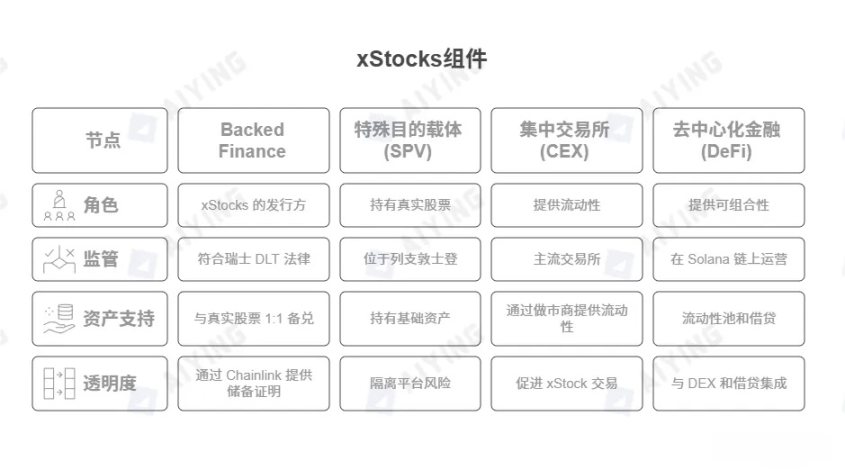
Currently, xStocks supports 61 stocks and ETFs, 10 of which have been traded on-chain, showing initial market vibrancy. After being backed by Bybit and Kraken, its trading volume exploded, reaching $6.641 million in daily trading volume as of July 1, with more than 6,500 users and more than 17,800 transactions.

Issuer and Regulatory Framework:
xStocks is issued by Backed Finance, a Swiss company, and its operations follow the Swiss DLT (Distributed Ledger Technology) Act. Switzerland was chosen as the legal home base because the country offers a relatively clear and friendly regulatory environment for digital assets and blockchain innovation.
Special Purpose Vehicles (SPVs):
This is the cornerstone of the entire architecture. Backed Finance has set up a Special Purpose Vehicle (SPV) in Liechtenstein, where the legal and tax environment is stable. This SPV is like an "asset safe" whose sole function is to hold real shares. This design achieves critical risk isolation: even if the platform on which the user trades (such as Kraken or Bybit) or the issuer has operational issues, the underlying assets held in the SPV remain safe and independent.
Asset-backed and liquidity strategies
To ensure the value and credibility of on-chain tokens, xStocks has established a transparent asset-backed and dual-track liquidity system.
1:1 Anchor (1 coin = 1 share):
Every xStock token circulating on-chain strictly corresponds to a real share held in a third-party custodian. This 1:1 anchoring relationship is at the heart of its value proposition. Currently, NVIDIA, Circle, and Tesla each have more than 10,000 stock tokens.
Issuance process:
Professional accredited investors can apply for a Backed Account to purchase shares through Backed. Backed plays the role of a primary investor, buying shares from a brokerage, which are then held in escrow by a third-party institution. Finally, xStocks mints a corresponding number of tokens based on the number of shares purchased and returns them to Tier 1 investors. These Tier 1 investors can issue and redeem equity tokens at any time.
Proof of Reserve:
Transparency is the cornerstone of trust. xStocks is integrated with Chainlink PoR, the industry's leading oracle network. This means that anyone can query and verify Backed Finance's reserve vault on-chain in real-time and autonomously, ensuring that the real number of shares they hold is sufficient to support all issued tokens.
Dual-track liquidity strategy:
1. Centralized Exchange (CEX) Market Makers:
On major exchanges such as Kraken and Bybit, professional market makers are responsible for providing liquidity, ensuring that users can buy and sell xStocks as easily as they would regular cryptocurrencies.
2. Decentralized Finance (DeFi) Protocols:
The tokens of xStocks are open, and users can deposit them into DeFi protocols (e.g., lending platforms, DEX liquidity pools) on the Solana chain to provide liquidity and earn yield on their own. Currently, xStocks has partnered with DEX aggregator Jupiter and lending protocol Kamino to take full advantage of DeFi's composability and create additional value for assets. For example, the most traded SP500 (SPY) token has reached $1 million in USDC-margined liquidity on the chain.
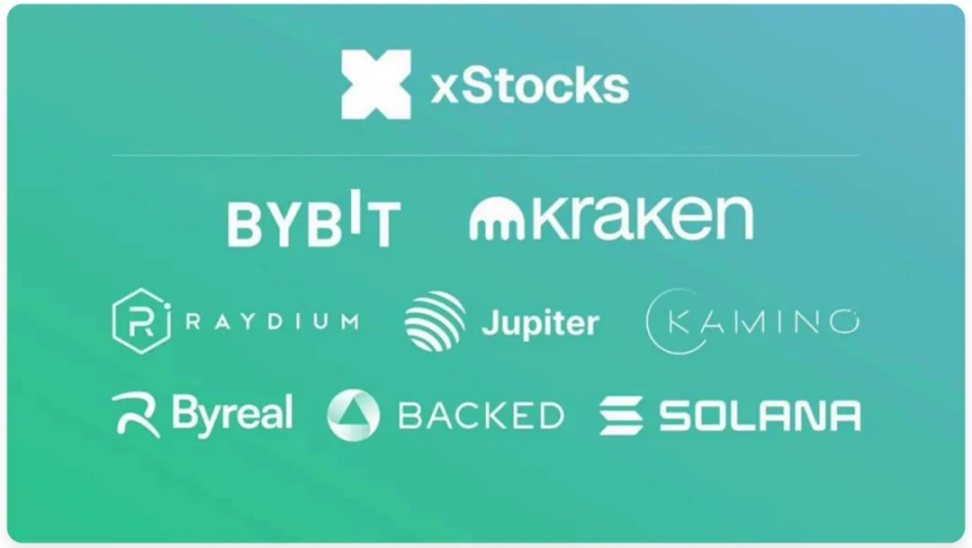
The xStocks ecosystem consists of publisher Backed, trading platforms Bybit and Kraken, and underlying blockchain Solana
Model 2: Robinhood – A "Walled Garden" with Compliance First
Core Definition: Unlike xStocks, a stock token purchased by a user on the Robinhood platform is not legally a stock ownership, but a financial derivatives contract between the user and Robinhood Europe that tracks the price of a specific stock. Its legal essence is over-the-counter (OTC) derivatives, and the on-chain token is only a digital certificate of the rights of this contract.
1. Legal framework and technical implementation
The Aiying team found Robinhood's model to be a very pragmatic form of "regulatory arbitrage", which cleverly packaged the product as an existing financial instrument with a clear regulatory framework and quickly deployed it at a very low cost.
Issuer and Regulatory Framework:
The tokens are issued by Robinhood Europe UAB, an investment company registered in Lithuania and regulated by its central bank. Its products are regulated under the European Union's MiFID II (Markets in Financial Instruments Directive) framework. According to MiFID II, these tokens are classified as derivatives, bypassing more complex securities issuance regulations.
Low-cost and rapid deployment:
Robinhood deployed 213 stock tokens on the Arbitrum chain at a total cost of just $5.35 (on-chain gas fees), demonstrating extreme efficiency in leveraging Layer 2 technology. Of these, 79 tokens have metadata set and are ready for subsequent transactions.
Pioneering Attempts:
Robinhood boldly made its first foray into tokenization of shares of private companies, launching tokens from OpenAI and SpaceX in an attempt to get a head start in the high-value space of private equity. Currently, Robinhood has minted 2,309 OpenAI(o) tokens. (The OpenAI token will provide investors with the opportunity to invest indirectly in OpenAI through Robinhood's ownership in the SPV, and then pegging the price of the OpenAI token to the value of OpenAI shares held by that SPV)
2. "Walled garden" style technical and compliance design
Robinhood's technology implementation is tightly tied to its compliance strategy, and together they build a closed but compliant ecosystem.
On-chain KYC & Whitelist:
Through a reverse analysis of Robinhood's stock token smart contract, the community developers found that strict permission controls were embedded in their contracts. Each token transfer triggers a check to verify that the recipient's address is in the "Approved Wallet" registry maintained by Robinhood. This means that only EU users who have passed Robinhood KYC/AML will be able to hold and trade these tokens, creating a "Walled Garden".
Limited DeFi Composability:
As a direct consequence of this "walled garden" model, its stock tokens are virtually impossible to interact with expansive, permissionless DeFi protocols. The on-chain value of the asset is firmly locked within Robinhood's ecosystem.
Future Planning (Robinhood Chain):
To better serve its RWA strategy, Robinhood plans to develop its own Layer 2 network, Robinhood Chain, on top of the Arbitrum technology stack, demonstrating its ambition to take control of the underlying technology.
Although Robinhood's model has found a path to compliance under the EU framework, it has also caused a lot of controversy and potential risks.
"Fake Equity" Turmoil:
The most emblematic events are its launch of OpenAI and SpaceX tokens. Soon after, OpenAI officially made a public statement, denying working with Robinhood and making it clear that the tokens do not represent the company's equity. This incident exposes the huge risks of the derivatives model in terms of information disclosure and user perception.
Centralization Risk:
The security of the user's assets and the execution of the transaction are completely dependent on the operational health and creditworthiness of Robinhood Europe. If there is a problem with the platform, the user will be exposed to counterparty risk.
3. Comparison and summary of the two major models
Through the above analysis, we can clearly see the fundamental differences between the two models. The xStocks model is closer to the open spirit of Crypto Native and DeFi, while the Robinhood model is a "shortcut" to finding within the existing regulatory framework.
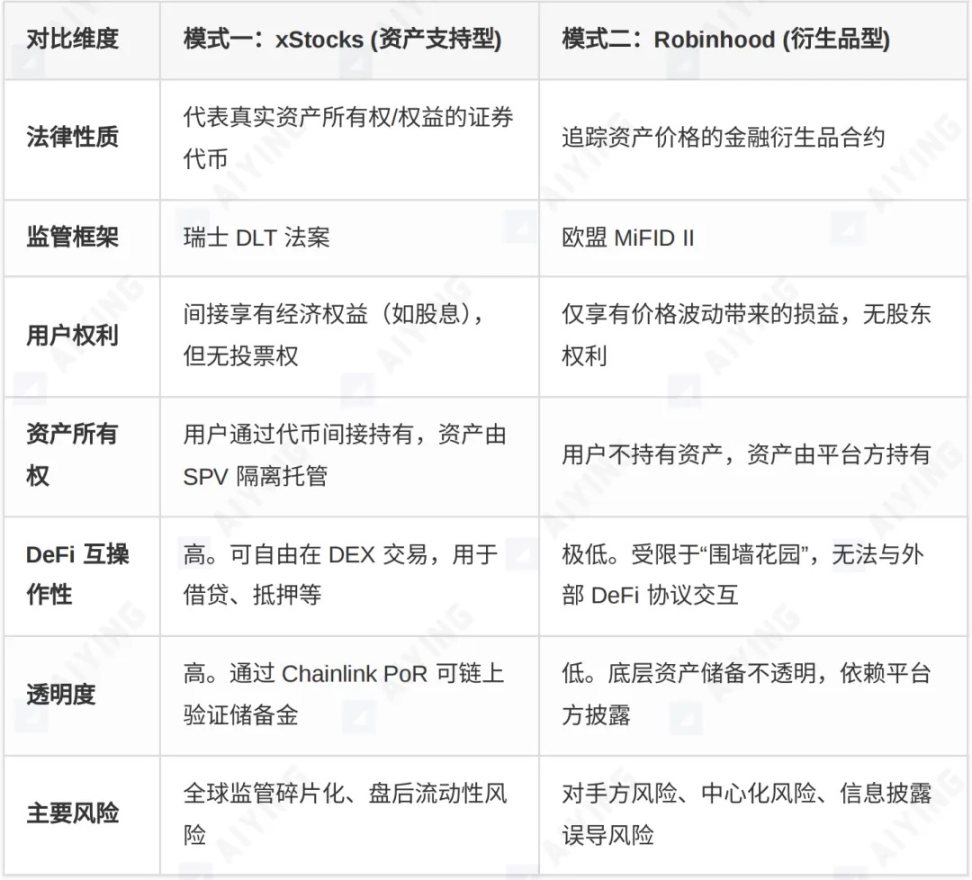
Key takeaways:
The path of xStocks is "asset on-chain", which tries to truly and transparently map the value of traditional assets to the blockchain world and embrace open finance. Robinhood's path is "business on-chain", which uses blockchain as a technical tool to package and deliver its traditional derivatives business, which Aiying understands is essentially more like a blockchain-based upgrade of "CeFi" (centralized finance).
2. Core analysis (2): The "Song of Ice and Fire" of the technical architecture - open DeFi and walled gardens
Under the compliance framework, the technology architecture is the backbone that enables the product vision. Aiying believes that the differences between xStocks and Robinhood in terms of technology selection and component design also reflect their two different philosophies of "openness" and "closure".
1. The choice of the underlying public chain: a triangular game of performance, ecology and security
Choosing which public chain to use as the "soil" for asset issuance is a strategic decision related to performance, cost, security, and ecology.
xStocks Chooses Solana:
The core motivation is the pursuit of extreme performance. Solana is known for its high throughput (theoretical TPS up to tens of thousands), low transaction costs (typically less than $0.01), and sub-second transaction confirmation speeds. This is critical for stock tokens that need to support high-frequency trading and real-time interaction with complex DeFi protocols. However, several network outages in history have also exposed stability challenges, which is a risk that must be taken when choosing Solana.
Robinhood Chooses Arbitrum:
Arbitrum is Ethereum's Layer 2 scaling solution, and the logic behind its choice is to "stand on the shoulders of giants". By adopting Arbitrum, Robinhood not only achieves higher performance and lower fees than the Ethereum mainnet, but more importantly, inherits Ethereum's unparalleled security and large developer community and mature infrastructure. In addition, Robinhood has also announced plans to migrate to its own Layer 2 network based on Arbitrum technology in the future, optimized specifically for RWA, showing its ambition for a long-term layout.
Comparative analysis: This is not simply a question of "who is better", but a reflection of the strategic path. Solana is a monolithic chain that pursues "integrated high performance", while Arbitrum represents a path of "modularity" and inheritance of Ethereum security. The former is more aggressive, the latter is more robust.
2. Analysis of core technical components
In addition to the underlying public chain, several key technical components together constitute the core function of the stock tokenization product.
Smart Contract Design:
-
xStocks (SPL Token):
As a standard token (SPL) on Solana, its smart contracts are designed to be freely transferable, similar to ERC-20 on Ethereum. This open design is the technical foundation for its ability to seamlessly integrate with DeFi protocols, such as as using the Kamino lending platform as collateral.
-
Robinhood (Permissioned Token):
As mentioned earlier, the contract has a transfer restriction logic embedded in it. Each transaction is verified by invoking an internal whitelist registry, which is the technical core of its "walled garden" model and the root cause of its isolation from open DeFi protocols.
The key role of oracles (using Chainlink as an example):
-
Price Information:
The value of a stock token needs to keep pace with the real-world share price. Oracles, such as Chainlink Price Feeds, act as data bridges, feeding stock prices from multiple trusted data sources to smart contracts securely and decentrally, which is the lifeblood for functions such as maintaining price pegging, executing trades, and conducting liquidations.
-
Proof of Reserves (PoR):
For a 1:1 anchored product like xStocks, it's crucial. With Chainlink PoR, smart contracts can automatically and regularly prove the adequacy of their off-chain reserve assets to the outside world, solving the trust problem at the code level and making it far more timely and convincing than traditional audit reports.
Cross-chain interoperability (using Chainlink CCIP as an example):
-
Value:
With the formation of a multi-chain pattern, the cross-chain capability of assets has become crucial. The Cross-Chain Interoperability Protocol (CCIP) allows assets such as xStocks to be securely transferred between different blockchains, such as from Solana to Ethereum. This can break down the silos between chains, greatly expand the liquidity pool and application scenarios of assets, and is a key technology to realize the vision of "one token, 10,000 chains". Backed Finance has mentioned the use of Chainlink CCIP for cross-chain bridging in its products.
3. Detailed explanation of asset on-chain and SPV operation
For asset-backed tokens, SPVs are a key hub that connects real-world assets to the blockchain world. Its operational processes are rigorous and interlocking, ensuring the safety and compliance of assets.
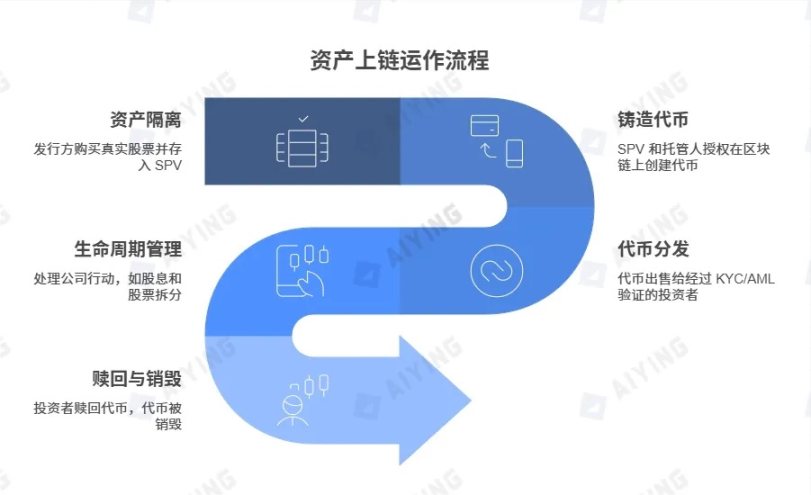
1. Asset Isolation:
Issuers, such as Backed Finance, first buy real shares in a compliant financial market, such as the NYSE. These shares are not placed on the issuer's own balance sheet, but are held in a separate, regulated special purpose vehicle (SPV) and held in custody by a third-party licensed custodian such as a bank.
2. Token Minting:
Once the SPV and custodian confirm the receipt of the real asset, they send a verified instruction to the on-chain smart contract authorizing the minting of an equivalent amount of tokens on the target blockchain (e.g., Solana) (e.g., 100 TSLAX tokens for depositing 100 shares of TSLA).
3. Token Distribution:
Minted tokens are sold through compliant exchanges (such as Kraken) or directly to accredited investors who have passed KYC/AML audits.
4. Lifecycle Management:
During the duration of the token, the issuer handles corporate actions through smart contracts and oracles. For example, when Tesla Inc. pays out a dividend, the SPV receives the dividend and triggers a smart contract to distribute the equivalent amount of stablecoins or tokens to on-chain holders. In the case of a stock split, the smart contract automatically adjusts the number of tokens for all holders.
5. Redemption & Burning:
When accredited investors wish to redeem, they send on-chain tokens to a designated burn address. Once the smart contract is verified, the SPV is notified. The SPV then sells the corresponding amount of real shares in the traditional market and returns the cash received to investors. At the same time, the on-chain tokens are permanently burned to ensure that the on-chain circulation and off-chain reserves are always in a 1:1 balance.
3. Core analysis (3): Business model and risk assessment - the "reef" behind the opportunity
Behind the complex compliance and technology architecture is a clear business logic. The stock tokenization platform not only creates unprecedented value for users, but also opens up new profit channels for itself. However, opportunities and risks always come with them.
1. Business model and source of profit
Although they all offer stock token trading, different platforms have their own profit models.
Robinhood's Sources of Revenue:
-
Explicit Income:
According to its official statement, Robinhood mainly charges a 0.1% foreign exchange (FX) conversion fee for transactions made by non-Eurozone users. This fee is incurred when a user buys a token denominated in USD using EUR.
-
Potential Income:
Although it currently focuses on "zero commission" to attract users, its business model is scalable. In the future, it may introduce monetization methods similar to its traditional U.S. stock business, such as Order Flow Payment (PFOF), although it is strictly restricted in the EU, membership value-added services for high-frequency traders, or income from the underlying assets held.
-
Expanding into the Private Equity Market:
By issuing tokens from private companies such as OpenAI and SpaceX, Robinhood has expanded its high-value asset class, which is not only a powerful user acquisition strategy, but may also be profitable in the future through related value-added services (such as messaging, transaction matchmaking) fees.
xStocks (Kraken & Backed Finance)'s revenue streams:
-
Transaction Fees:
Kraken, as one of the core trading platforms, charges a percentage of transaction fees for buyers and sellers of xStocks, which is the exchange's most traditional profit model.
-
Minting/Redemption Fee:
As the issuer, Backed Finance mainly serves institutional clients. It may charge a service fee for large minting and redemption operations performed by institutional users to cover their costs of purchasing, hosting, and managing the underlying assets.
-
B2B Services:
The core business model of Backed Finance is to provide a one-stop Tokenization-as-a-Service solution for other financial institutions. xStocks is both a product and a showcase of its technological prowess.
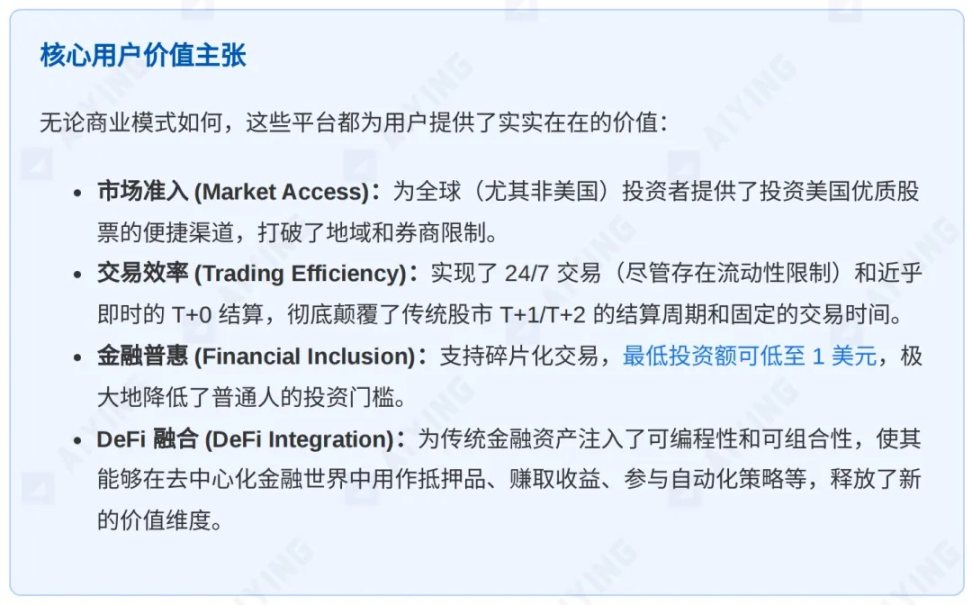
2. Comprehensive risk assessment matrix
While investors enjoy the convenience brought by stock tokenization, they must be soberly aware of the various risks hidden behind it.
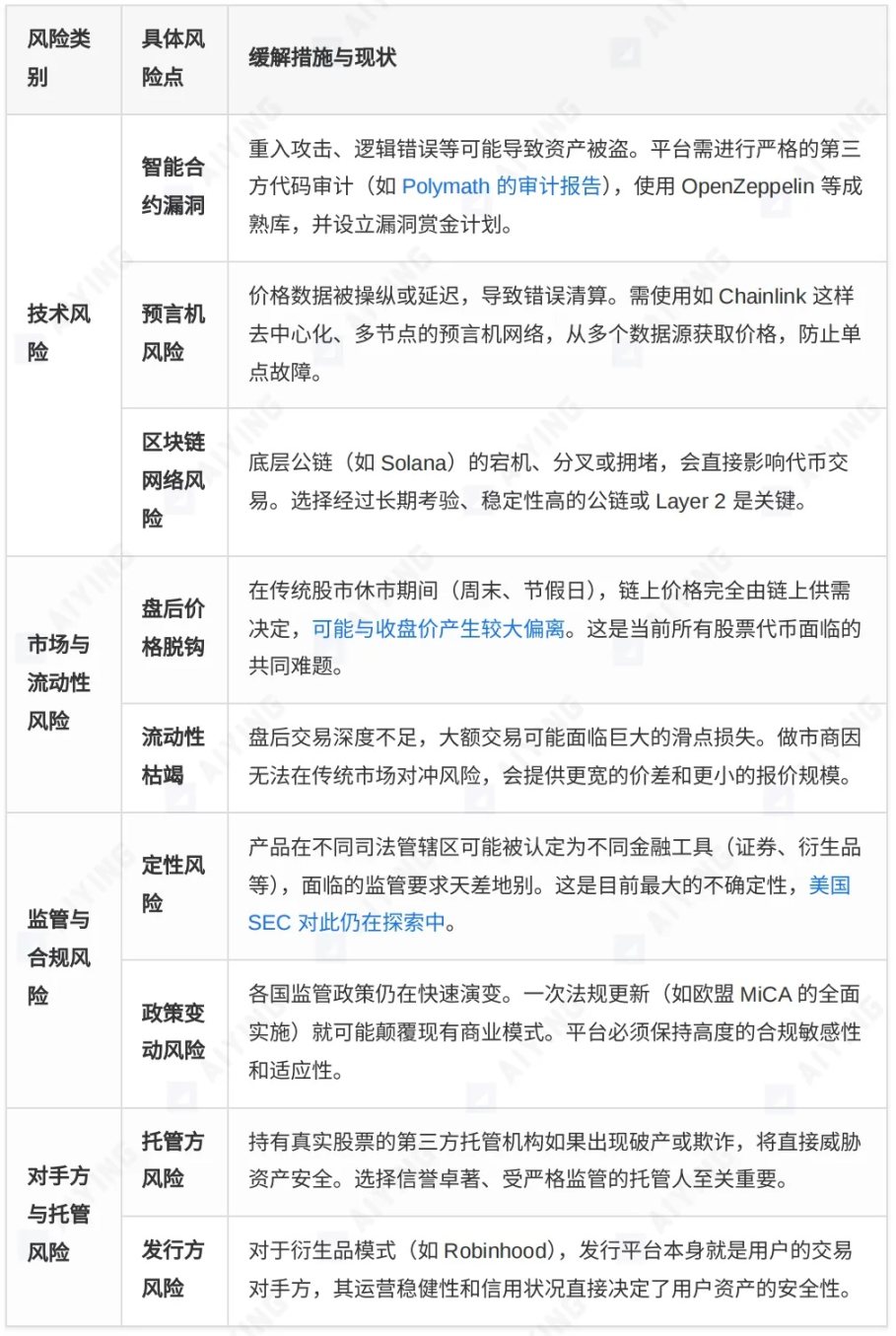
3. Market structure and future outlook: Who will dominate the next generation of financial markets?
In the asset tokenization track, major platforms are competing for the market with different strategic positioning. Understanding their differences can help us gain insight into the future of the industry.
1. Comparison of the main player matrix
The RWA tokenization track is a multitude of competitors based on different strategic considerations. We divided the main players into three camps for an in-depth comparison.
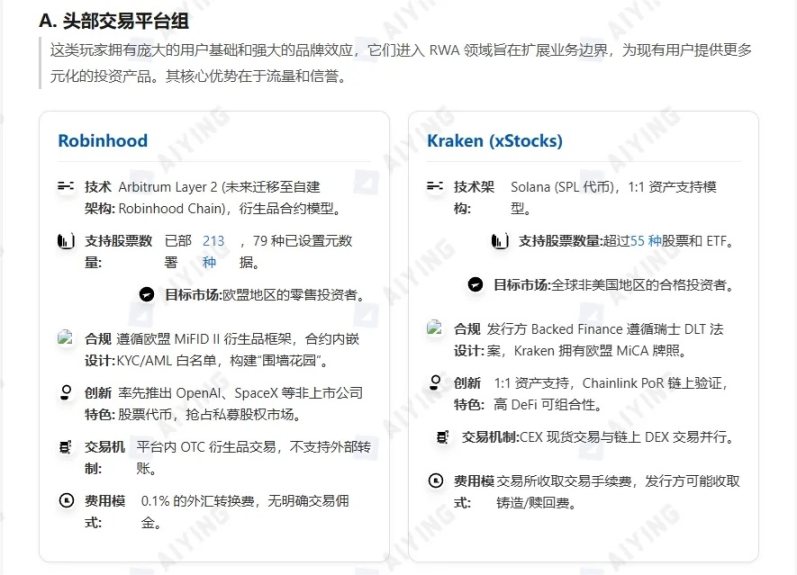
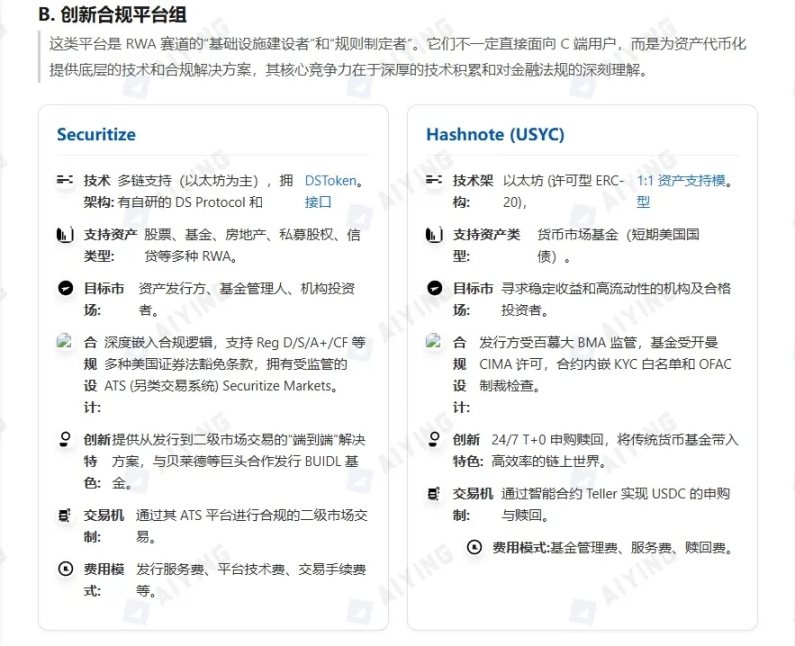
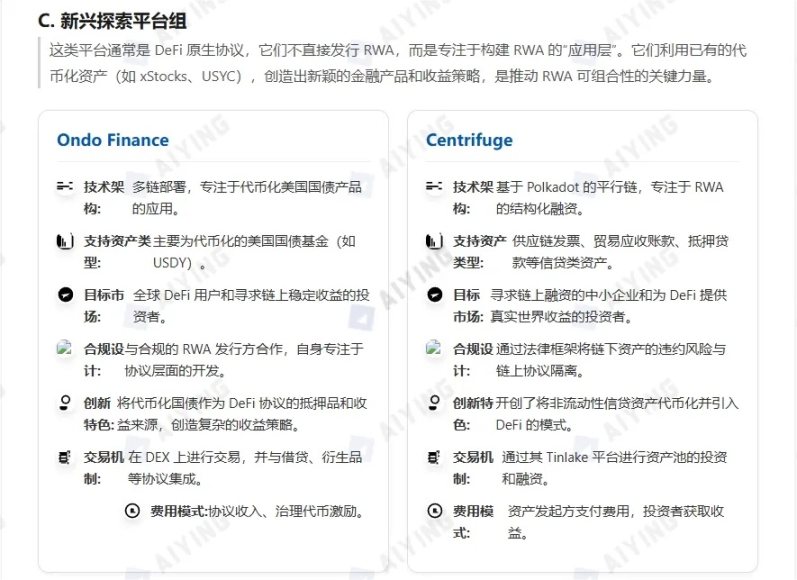
2. Market trends and evolution paths
Looking ahead, there are several clear trends emerging from stock tokenization and the RWA track as a whole:
-
From Isolation to Convergence:
Early tokenization projects were mostly isolated attempts within a single platform. Today, the trend is shifting to deep integration with mainstream financial institutions such as BlackRock, Franklin Templeton, and the vast DeFi ecosystem. Tokenized assets are becoming a bridge between TradFi and DeFi.
-
Regulation-Driven Innovation:
Regulatory clarity is the strongest catalyst for market development. The European Union's MiCA Act, Switzerland's DLT Act, and MAS's Guardian Scheme are all providing greater clarity to the market, which in turn is incentivizing more compliance innovation. Compliance capabilities are becoming the core competitiveness of the platform.
-
Institutional Admission & Product Diversification:
As BlackRock brings the trillion-dollar money market to the blockchain through its BUIDL fund, institutional participation will inject unprecedented liquidity and trust into the market. The product range will also expand from a single equity and bond to more complex structured products, private equity and alternative assets.
-
Private Equity Tokenization Becomes the New Blue Ocean:
Platforms represented by Robinhood are beginning to explore the tokenization of shares of private companies, which opens a window into the private equity market, which is usually limited to institutional and high-net-worth individuals. Although there are huge challenges in valuation, disclosure and law, this is undoubtedly a new direction with great potential.
Future outlook and thinking
The wave of stock tokenization is unstoppable, but the road ahead is not easy. A few core questions will determine its final form:
Open vs. Closed Controversy:
Will the market be dominated by an open, composable model like xStocks, or will a compliant, but closed, "walled garden" model like Robinhood win? More likely, the two will coexist for a long time, serving user groups with different risk appetites and needs. Crypto Native users will embrace the open world of DeFi, while traditional investors may prefer to experiment in a familiar, regulated "garden".
The race between technology and law:
Cross-chain technologies (e.g., CCIP), Layer 2 solutions, and privacy-preserving computing (e.g., ZK-proofs) will continue to evolve to address current technical bottlenecks in scalability, interoperability, and privacy. At the same time, the ability of the global legal framework to keep pace with technological innovation and provide certainty for these innovations will determine the speed and ceiling of the industry as a whole.
Stock tokenization is much more than simply "on-chain" financial assets, it is fundamentally reshaping the paradigm of asset issuance, trading, liquidation, and ownership. It promises a more efficient, transparent, and inclusive global financial market. Although this path is full of technological, market and regulatory "reefs", the future direction it points to is undoubtedly irreversible. For all market participants, whether investors, builders or regulators, it is imperative to actively and prudently embrace the coming financial revolution on the basis of a deep understanding of its underlying logic and potential risks.
